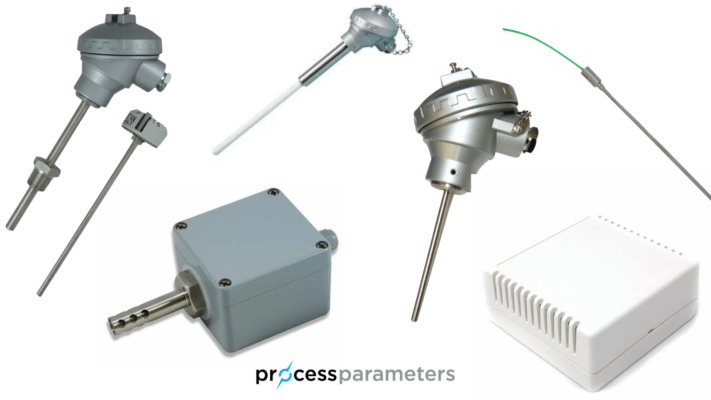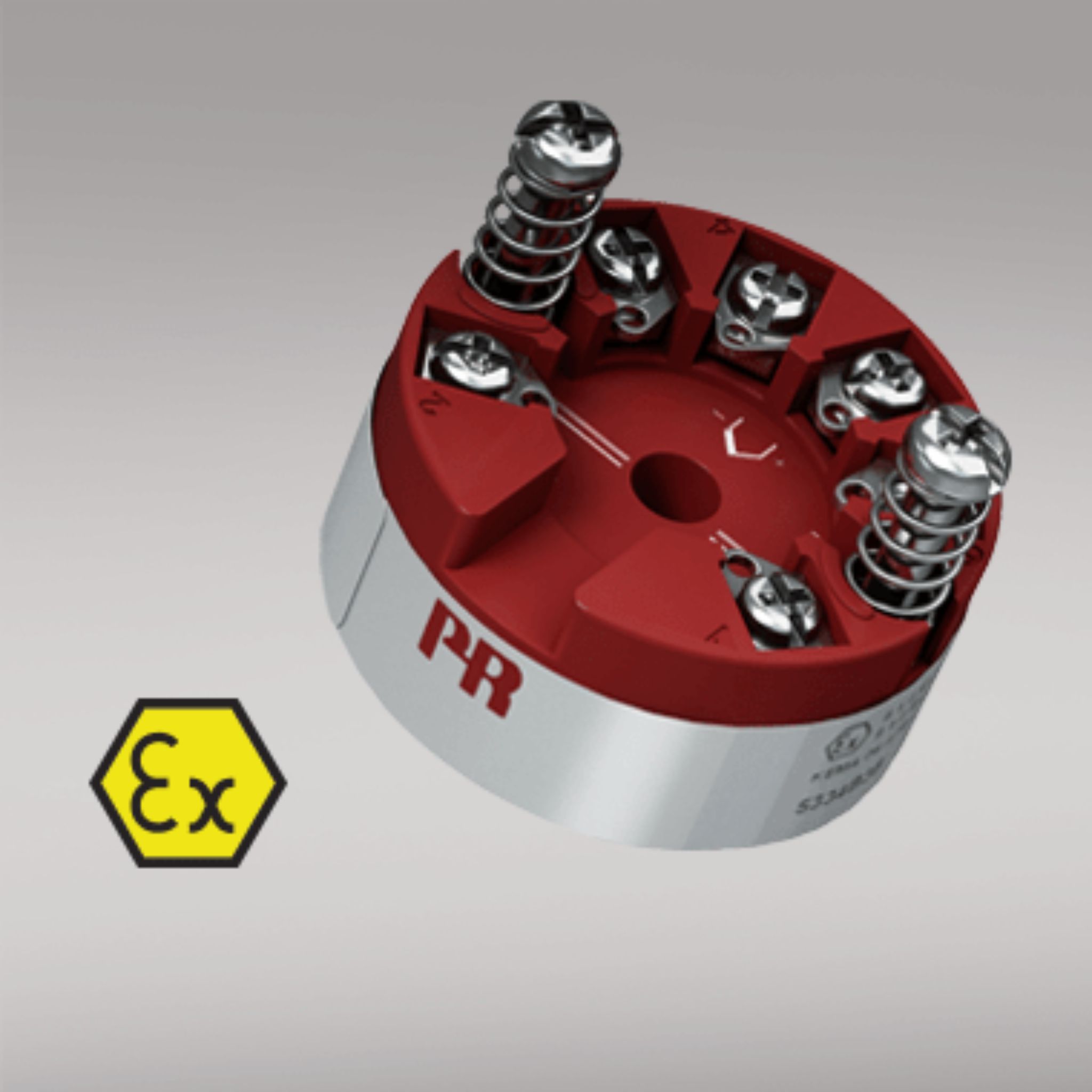What is a Temperature Transmitter?
What is a Transmitter? Temperature Transmitter Working Principle
Temperature control is a crucial aspect of many industrial processes, and temperature transmitters are essential for ensuring accurate measurement and readings.
These devices serve as a bridge between a control system and a temperature sensor, transforming analogue thermal measurements into linearised analogue output signals with less background noise. Using a transmitter allows signals to be sent longer distances.
As a result, temperature monitoring becomes more precise with minimal interference. Temperature transmitters come in various shapes and sizes and can work with different temperature sensors such as thermocouples and RTD temperature sensors.
Temperature transmitters from Process Parameters can be configured to meet the requirements of your application. We support your compact temperature transmitter requirements whatever the measurement design, in head or DIN Rail mounting.
Contact Us4-20mA Temperature Transmitters
PR Electronics 5335D In Head HART Temperature Transmitter – ATEX
4-20mA Temperature Transmitters
4-20mA Temperature Transmitters
PR Electronics 5334B ATEX Temperature Transmitter – Thermocouple Input
4-20mA Temperature Transmitters
This article provides an overview of temperature transmitters and their role in industrial processes.
What is a Temperature Transmitter?
A temperature transmitter is a device connected to a temperature sensor that transmits and converts sensor signals into a readable format for monitoring and controlling purposes. The ‘output signal’ represents the process variable temperature being measured and controlled, with the most common reading being 4 to 20 mA.
Once the signal is conditioned to a usable level, it can be transmitted through copper wire and used to drive other equipment within industrial processes. This might include controllers, computers, meters, data loggers, or chart recorders.
Where Are Temperature Transmitters Used?
Temperature transmitters are used in various industries and applications where precise temperature monitoring and control are crucial. Common applications include industrial processes (chemical, petrochemical, and manufacturing), HVAC systems, pharmaceutical manufacturing, food and beverage production, power generation, and environmental monitoring.
They ensure that temperatures remain within safe and efficient ranges, preventing equipment damage, ensuring product quality, and enhancing overall operational efficiency. Temperature transmitters are essential in any situation where accurate temperature data is needed for process optimisation, safety, or compliance with regulatory standards.
How to Use a Temperature Transmitter
Temperature transmitters can be manufactured as stand-alone devices or integrated into a component’s connection head. When integrated into a component’s connection head, temperature transmitters require fewer wiring connections and take up less space in the control system.
This arrangement also provides an improved mechanical connection that is less susceptible to corrosion from process gases, vapours or temperatures. However, the functionality of a temperature transmitter is usually determined by the application requirements.
Proper installation and wiring can significantly improve the accuracy and reliability of temperature monitoring. In most cases, temperature transmitters are connected to one or more temperature monitors in a process control system, and the signals are made available as an immediate reading.
The data can then be transferred further down the measuring chain for additional processing.
Advantages of Temperature Transmitters
Temperature transmitters offer significant advantages over directly wired temperature monitors. Here’s a summary of the advantages, which we expand on in detail below:
- They eliminate the need for special cabling requirements and simplify engineering and maintenance.
- They enable advanced diagnostics and offer much greater noise resistance over long distances.
- Transmitters can isolate, amplify, filter noise, linearise, and convert input signals from sensors.
- The output signal from temperature transmitters works with many standard devices.
- Transmitters don’t require expensive extension wires.
Simplify Engineering and Maintenance
Temperature transmitters can be integrated into a component’s connection head, which reduces wiring requirements and the instrument footprint. This makes installation and maintenance much simpler and more cost-effective.
Advanced Diagnostics
Enable advanced diagnostics that can help detect issues with temperature readings or system components. This makes it easier to troubleshoot problems and reduce downtime.
Greater Noise Resistance
Temperature transmitters offer much greater noise resistance than directly wired temperature monitors. This is especially important over long distances where electrical noise can be problematic. Temperature transmitters also have high immunity to ambient electrical noise.
Isolate, Amplify, Filter Noise, Linearise, and Convert Input Signals
Temperature transmitters can isolate, amplify, filter noise, linearise, and convert input signals from sensors. This ensures accurate temperature readings and eliminates interference from other electrical signals.
Output Signal Compatibility
The output signal from temperature transmitters works with many standard devices, which makes it easy to integrate them into existing temperature monitoring systems.
Reduced Cost
Temperature transmitters don’t require expensive extension wires, which reduces the overall cost of a temperature monitoring system. They also use low-voltage signals that can be transmitted over ordinary copper wire, which further reduces costs.
Features of a Temperature Transmitter
A temperature transmitter is a crucial device for measuring and monitoring temperature changes in industrial processes. Here are some of the essential features of a temperature transmitter:
Two-Wire Output: Transmitters provide a two-wire output with the same wiring used for power and output. The load resistance is connected in series with a DC power supply, and the current drawn from the supply is a 4-20 mA or output signal that is proportional to the input signal.
Remote Mounting: Two-wire transmission permits remote mounting of the transmitter near the sensor to minimise the effects of noise and signal degradation to which low-level sensor outputs are susceptible.
Rugged Enclosure: A rugged metal enclosure, suitable for field mounting, offers environmental protection and screw terminal input and output connections. This enclosure may be either surface or standard relay track mounted.
Linearisation: Most temperature transmitters are linearised to the signal produced by the thermocouple or RTD, although there are new models now available that are linearised to the actual temperature.
Output Signal: The temperature transmitters convert the thermocouple or RTD signal to a 4-20 mA output signal.
Model Variations: Transmitters are available with dip switch selection for several thermocouple types per model, as well as thermocouple and RTD selection on a single model. RTD or thermocouple transmitters are available in either isolating or non-isolating models, and they also feature output ranging adjustments with zero and span adjustments over 80 to 100% (depending on the model) of the sensor range.
Calibration: Signal Reference Calibrators and software are used for calibration, and some devices come with advanced features such as digital communication protocols and diagnostics.
How Does a Temperature Transmitter Work?
A temperature transmitter works by drawing in the current from the remote DC power supply connected to the sensor input. The actual signal is transmitted as a change in the power supply, and only two copper wires are needed to connect the temperature transmitter.
The device can scale the temperature, allowing for customisation to meet the needs of the application.
What’s the Difference Between a Temperature Sensor and a Temperature Transmitter?
While a temperature sensor measures or senses the physical temperature and converts it into measurable units of electrical current, including voltage or resistance, a temperature transmitter is a device connected to the sensor that converts the measured temperature into a signal to be seen, logged, and maintained.
Both devices have critical roles in ensuring accurate temperatures are measured and communicated for control.
Temperature Sensor
A temperature sensor is a device that measures temperature through an electrical signal generated by two metals that produce electrical voltage or resistance in response to temperature changes. These signals can be converted into a temperature reading.
For more information about temperature sensors, read our article: What Is A Temperature Sensor?

Temperature Transmitter
A temperature transmitter is an electrical instrument that interfaces with the temperature sensor to isolate, amplify, filter noise, and convert the signal from the sensor to send it to the control device. Its primary function is to measure and alert temperature changes.
Temperature Transmitters From Process Parameters
A temperature transmitter is an essential device for accurate temperature measurement and monitoring in industrial processes. It’s connected to a temperature sensor and converts analogue thermal measurements into digital output signals with minimal interference, which represents the process variable temperature being measured and controlled.
The advantages of using temperature transmitters include eliminating the need for special cabling requirements, enabling advanced diagnostics, and offering much greater noise resistance over long distances.
Process Parameters provides various temperature transmitters that can work with different temperature sensors such as thermocouples and RTDs.
If you would like advice on temperature transmitters or a quote, please do not hesitate to contact the team at Process Parameters. Call us at 01628 778688 or send us an email here.
Contact Us4-20mA Temperature Transmitters
PR Electronics 5335D In Head HART Temperature Transmitter – ATEX
4-20mA Temperature Transmitters
4-20mA Temperature Transmitters
PR Electronics 5334B ATEX Temperature Transmitter – Thermocouple Input
4-20mA Temperature Transmitters
FAQs
What industries use temperature transmitters?
They are widely used in various fields, including aerospace, chemical, food and beverage, energy, HVAC, pharmaceuticals, metal plating, mining, oil and gas, petrochemicals, waste and water management, and electronic OEMs.
What are the physical forms of a transmitter?
The three main forms of transmitters are DIN rail mounted, hockey puck, and microprocessor-based. Each type offers specific benefits, and the right form depends on the application’s requirements. DIN rail-mounted transmitters provide high-density mounting, while hockey puck transmitters offer a compact design. Microprocessor-based transmitters feature advanced features like digital communication protocols and diagnostics.
Related Articles:
- What Is A Temperature Sensor?
- What is a Thermometer?
- 5 Different Types of Thermal Sensors
- What is an RTD Sensor? What Are They Used For?
- Comparing Contact and Non-Contact Temperature Sensors
- How To Check if You Have a Faulty Temperature Sensor
- Use of Temperature Sensors in Glass Manufacturing Process
- Guide to Industrial Temperature Sensor Devices
- 5 Different Types of Thermal Sensors





